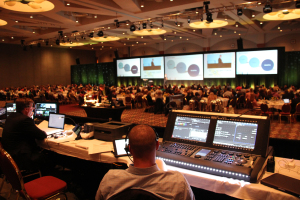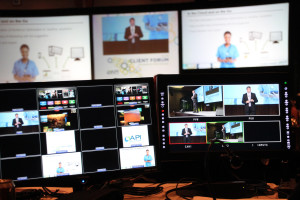There’s an old saying: “Murphy was an optimist.”
When it comes to A/V at your event, planning for the worst is the best medicine to beat Murphy’s Law. Thus, the importance of the Back-Up Plan.
A good Back-Up Plan includes two main elements – technology and process. Each of these components requires planning and foresight to be effective. The goal is to make any shift to your Back-Up Plan seamless to the audience.
First, let’s use a few examples to illustrate what can go wrong:
- Despite getting a list of frequencies from the in-house A/V supplier, you find that your microphones are suffering “bleed through” from another group’s event…
- Your high-priced keynote speaker who is only supposed to talk for 30 minutes, keeps going on, and on, and on – cutting into all your best laid plans and the speech time allotted for the president of your client’s company…
- Your video looks great projected in the atrium your client selected during cloudy weather. Then, the sun comes out…
- The computer your special entertainment is using for their presentation suddenly erupts in the “blue screen of death”…
- The presenter for your educational session suddenly takes ill (this may sound familiar…)
The key takeaway from these examples is that, for the most part, they are issues that are out of your control. Despite your expectations and plans, you suddenly have a situation that can sink your event. But not if you have an effective Back-Up Plan.
Technology
Having the right technology can save the day when the “stuff” hits the fan. If possible, certain pieces of technology should always be backed up for your main sessions – computers, projectors, and microphones. Having some additional gear for breakouts is also a great idea.
Computers are notoriously finicky. What works like a charm in your office can develop “amnesia” on site and suddenly not work the way it should. You should always have a second computer loaded with your presentation ready at a moment’s notice.
Running a backup computer in tandem with the main presentation computer provides peace-of-mind as well as other options, especially if you are dealing with guest speakers who like to bring their presentations to the show only minutes before they go on. (That never happens, right?)
The backup computer not only provides insurance in case the primary computer crashes, but also can become the main if a late presentation walks through the door and must be loaded on the presentation computer. A simple switch from one system to the other frees up computer number one to accept the new presentation; while computer number two chugs along merrily showing the current presentation.
The best way to back up your projectors is to have a second projector online and ready to go in case the main fails. This is accomplished by having the second projector hooked into your system, focused and running, but not projecting on the screen. Newer projectors have a “shutter” feature built in to block the projection(though be wary of how long the projector can burn in this mode – typically a few hours), while for older projectors you can simply keep the lens cap in place or put a piece of cardboard in front of the lens.
Some A/V suppliers will only charge half-price to have these projectors inline. Sometimes they will spec out projectors at lower lumens to serve as backups, which can save on budget.
Another option is to have the backup projectors in the room, but not set up. The advantage to this approach is that some A/V suppliers will not charge to have the backups present, as long as they are not used. This is a great way to have backups available quickly, without adding to your bottom line. If you have to use them, you’ll be very grateful they are handy.
While the visuals are important, audio is even more crucial in meetings. You can survive without your screens, but are dead without your mics. Backing up your microphones is generally very simple.
For that crucial speaker who is using a wireless lapel microphone, you can easily add a second wireless clip mic (some clips even are made to accommodate two microphones) for that speaker to ensure they will be heard.
Your wired podium microphone is another easy lifeboat if the wireless microphone fails. Having a wired hand microphone just off stage or tucked into the podium is a quick and simple way to keep your meeting going in case of a microphone mishap.
Technology can also save the day when outside circumstances damage the content of your show. If a presenter is late or missed their flight, you can use Skype to bring them into the meeting room from anywhere Internet access is available. (Of course, you need to have Skype on your computer first. This is a free download.) If they can’t get to the web, even piping in a speaker over a phone line is better than silence and excuses.
A recent example of using technology in a Back-Up Plan would be MPI-Wisconsin’s April event, where the team was able to still deliver the content of the keynote via video after the presenter had to cancel due to illness. Kudos to the April team for their quick thinking.
Process
Having an emergency plan in place before the curtain drops is crucial in dealing with unexpected twists.
The importance of rehearsal time with presenters can’t be stressed enough. If your presenters know what to do if the worst happens, your audience may see it as a mere blip on an otherwise perfect show. Tell your presenters what to do if their microphone fails. Have a script ready if the TelePrompTer goes down. Instill in your presenters the confidence that you have their back and won’t let them look foolish.

Tri-Marq used a five-screen approach for the event. Tri-Marq directed multiple general sessions, breakouts, and an awards show. In addition, Tri-Marq created three videos. One featured here, titled “Better Together,” announced the merger of the two companies at the meeting.
Large shows often benefit from a “doomsday” technical rehearsal, where each crew member is briefed on what to do if troubles strike. This reinforces the plan and helps the crew execute flawlessly and quickly. A few minutes of preparation can be the difference between a great show and one that is memorable for all the wrong reasons.
During the event, the theme slide is your best friend. If a computer goes down, go to the theme slide. If the presenter goes off script or off their slides, go to the theme slide. Lose the video signal from your camera or satellite feed, go to the theme slide. The theme slide buys you the time needed to find the right solution, while the audience often is none the wiser. The blank screen is your enemy – the theme slide can be your hero.
Of course, having a theme slide available may require having technology in place – a back up computer or the right kind of switcher – so, make sure you have the right gear to make your process work.
Above all, don’t panic. As long as sparks aren’t flying and the drape isn’t catching fire, most issues can be resolved. Having a plan “B” in place for unexpected turbulence can make all the difference.
Plan C
One final note. Sometimes, you have to have a plan “C.” Case in point: a show where one of the main projectors went down, and the backup projector would only fire if someone held down the “on” button. This required one brave soul to shimmy up the 10’ scaffolding next to the back wall and physically hold in the on button with their thumb until the next meeting break 45 minutes away. Luckily, I was a bit skinnier then…

